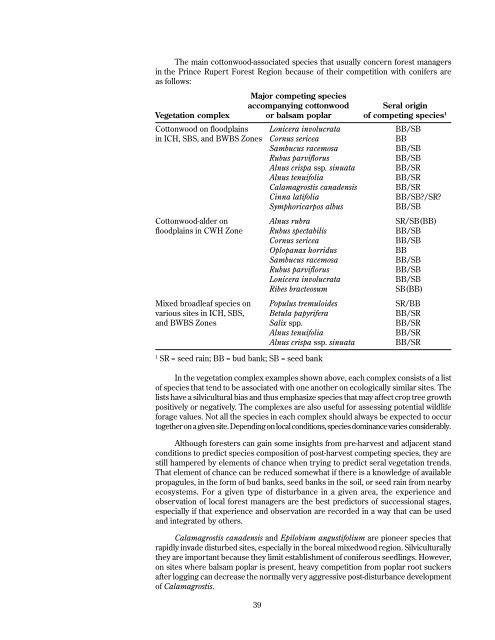FRDA Report: Black Cottonwood and Balsam Poplar Managers ...
FRDA Report: Black Cottonwood and Balsam Poplar Managers ...
FRDA Report: Black Cottonwood and Balsam Poplar Managers ...
You also want an ePaper? Increase the reach of your titles
YUMPU automatically turns print PDFs into web optimized ePapers that Google loves.
The main cottonwood-associated species that usually concern forest managers<br />
in␣ the Prince Rupert Forest Region because of their competition with conifers are<br />
as␣ follows:<br />
Major competing species<br />
accompanying cottonwood Seral origin<br />
Vegetation complex or balsam poplar of competing species1 <strong>Cottonwood</strong> on floodplains Lonicera involucrata BB/SB<br />
in ICH, SBS, <strong>and</strong> BWBS Zones Cornus sericea BB<br />
Sambucus racemosa BB/SB<br />
Rubus parviflorus BB/SB<br />
Alnus crispa ssp. sinuata BB/SR<br />
Alnus tenuifolia BB/SR<br />
Calamagrostis canadensis BB/SR<br />
Cinna latifolia BB/SB?/SR?<br />
Symphoricarpos albus BB/SB<br />
<strong>Cottonwood</strong>-alder on Alnus rubra SR/SB(BB)<br />
floodplains in CWH Zone Rubus spectabilis BB/SB<br />
Cornus sericea BB/SB<br />
Oplopanax horridus BB<br />
Sambucus racemosa BB/SB<br />
Rubus parviflorus BB/SB<br />
Lonicera involucrata BB/SB<br />
Ribes bracteosum SB(BB)<br />
Mixed broadleaf species on Populus tremuloides SR/BB<br />
various sites in ICH, SBS, Betula papyrifera BB/SR<br />
<strong>and</strong> BWBS Zones Salix spp. BB/SR<br />
Alnus tenuifolia BB/SR<br />
Alnus crispa ssp. sinuata BB/SR<br />
1 SR = seed rain; BB = bud bank; SB = seed bank<br />
In the vegetation complex examples shown above, each complex consists of a list<br />
of species that tend to be associated with one another on ecologically similar sites. The<br />
lists have a silvicultural bias <strong>and</strong> thus emphasize species that may affect crop tree growth<br />
positively or negatively. The complexes are also useful for assessing potential wildlife<br />
forage values. Not all the species in each complex should always be expected to occur<br />
together on a given site. Depending on local conditions, species dominance varies␣ considerably.<br />
Although foresters can gain some insights from pre-harvest <strong>and</strong> adjacent st<strong>and</strong><br />
conditions to predict species composition of post-harvest competing species, they are<br />
still hampered by elements of chance when trying to predict seral vegetation trends.<br />
That element of chance can be reduced somewhat if there is a knowledge of available<br />
propagules, in the form of bud banks, seed banks in the soil, or seed rain from nearby<br />
ecosystems. For a given type of disturbance in a given area, the experience <strong>and</strong><br />
observation of local forest managers are the best predictors of successional stages,<br />
especially if that experience <strong>and</strong> observation are recorded in a way that can be used<br />
<strong>and</strong> integrated by others.<br />
Calamagrostis canadensis <strong>and</strong> Epilobium angustifolium are pioneer species that<br />
rapidly invade disturbed sites, especially in the boreal mixedwood region. Silviculturally<br />
they are important because they limit establishment of coniferous seedlings. However,<br />
on sites where balsam poplar is present, heavy competition from poplar root suckers<br />
after logging can decrease the normally very aggressive post-disturbance development<br />
of Calamagrostis.<br />
39

















